Unity is teaming up with NXP Semiconductors, the world’s largest provider of automotive semiconductors, to demonstrate a human-machine interface (HMI) toolchain that operates on NXP’s popular i.MX 8QuadMax Applications Processor. The collaboration creates opportunities to bring real-time 3D experiences, including games made with Unity, to mass-production vehicles, regardless of their trim level and cost.
One of the biggest changes taking place in the automotive industry is the digitalization of the dashboard. From super-sized stretch screens that blend instrument clusters and infotainment systems to augmented reality-powered head-up displays (AR HUDs), human-machine interface (HMI) systems are rapidly becoming a battleground for automotive companies. Gorden Wagener, Chief Design Officer for Daimler AG, the parent company of Mercedes-Benz, made the stakes clear when he said, “Screens are the new horsepower.”
It’s not just the screen hardware that’s changing, but what’s shown on them. We’ve already seen games made with Unity, such as Cuphead, become playable in vehicles. Drivers and passengers today increasingly expect automakers to extend the games and other cutting-edge experiences that are available on their smartphones to their vehicles. But turning cars into smartphones on wheels is a difficult proposition, as current development processes are splintered across multiple production tools, which are often not up to the task of creating modern, responsive user experiences.
Unity has already become a platform of choice in prototyping and developing new HMI experiences. In fact, the first production vehicles with HMI systems running on Unity will hit the road this year.
The interactivity that real-time 3D provides is just one reason automakers – and other manufacturers creating products with an HMI component – are turning to Unity. With WYSIWYG (what you see is what you get) development, they can reduce development time throughout the HMI design and review stages and directly deploy to embedded targets (e.g., chipsets), therefore bridging the huge gap between design and engineering.
Designers and engineers no longer have to struggle with recreating the HMI numerous times to meet different design requirements, as they now can speak the same language and use Unity as an end-to-end HMI graphics toolchain across design, prototyping, development, and mass deployment. Learn more about Unity’s HMI toolkit here. Read More manufacturing | Unity Technologies Blog
